Printer-friendly .pdf version of this factsheet in English
Printer-friendly .pdf version of this factsheet in Spanish
Pathogen
Cercospora leaf spot (CLS) is caused by the fungus, Cercospora beticola.
Hosts
Table beet, sugar beet, spinach, Swiss chard, lambsquarters, and pigweed.
Significance
CLS is the most important foliar disease affecting table beet in New York. In processing table beet crops, epidemics cause significant defoliation and may disrupt mechanized harvest with top lifting machines. For fresh market table beet production, roots may be sold with intact foliage or separately. CLS lesions on the foliage are significant because it may lead to rejection for fresh market sales.
Symptoms
Disease symptoms are initially small, necrotic lesions surrounded by a red to purple margin in a red table beet cultivar (Fig. 1A). In a yellow cultivar, the margins of lesions are tan brown (Fig. 1B). CLS lesions have a tan to gray center on all cultivars. When the lesions are observed through a hand lens, tiny black pinpoint-like structures called pseudostromata (Fig. 2A) are visible carrying spores called conidia (Fig. 2B and 2C).
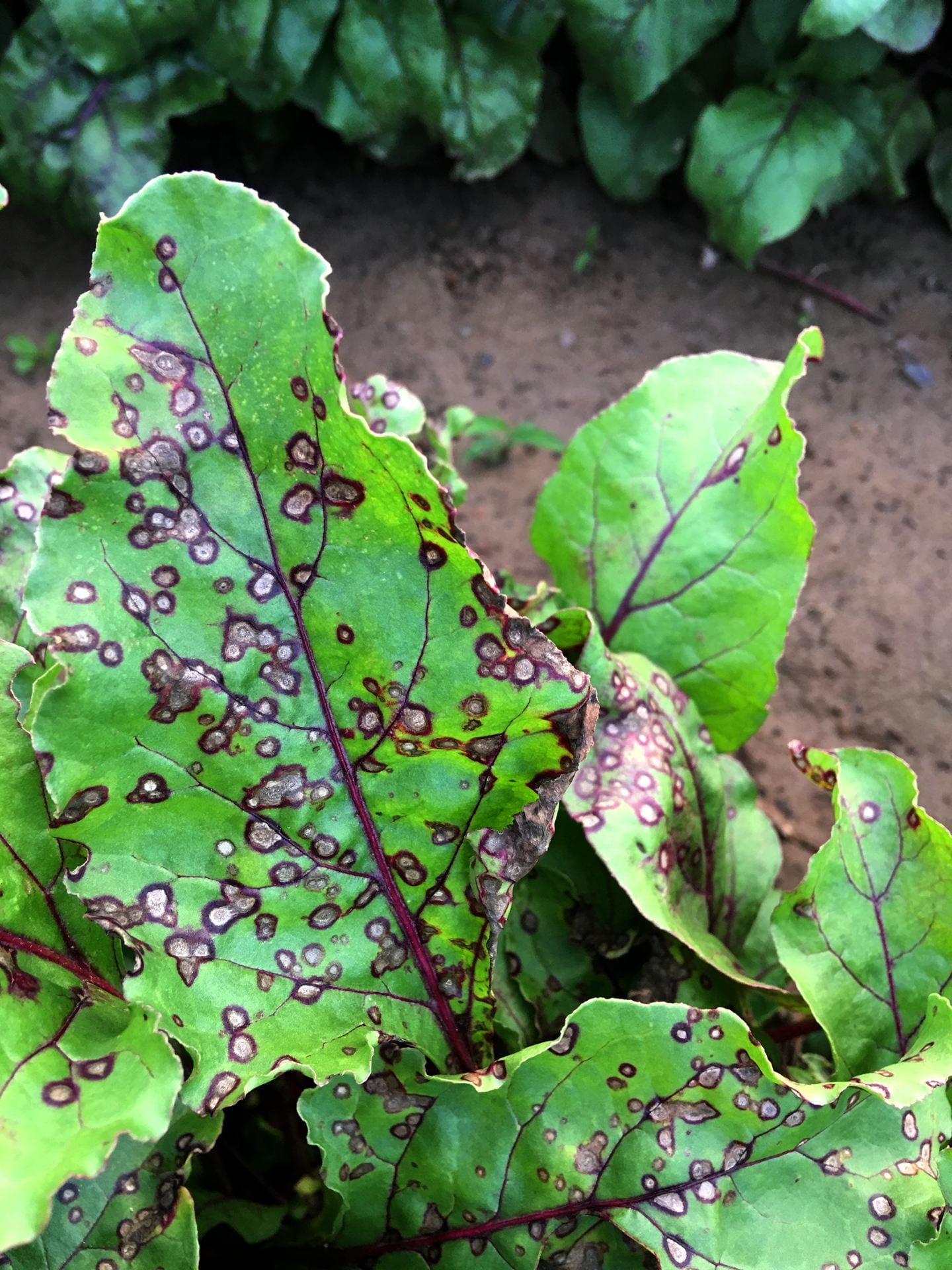
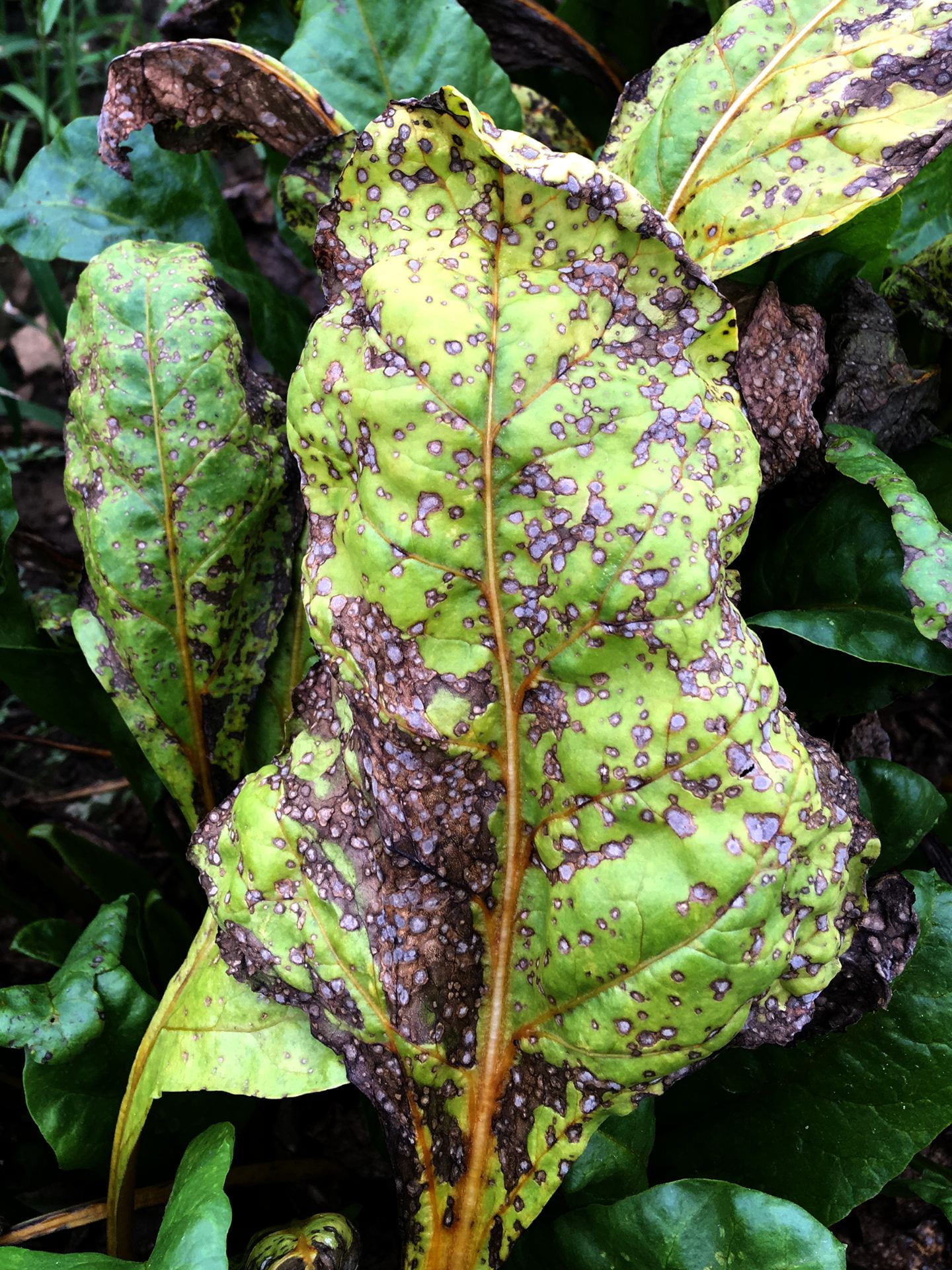
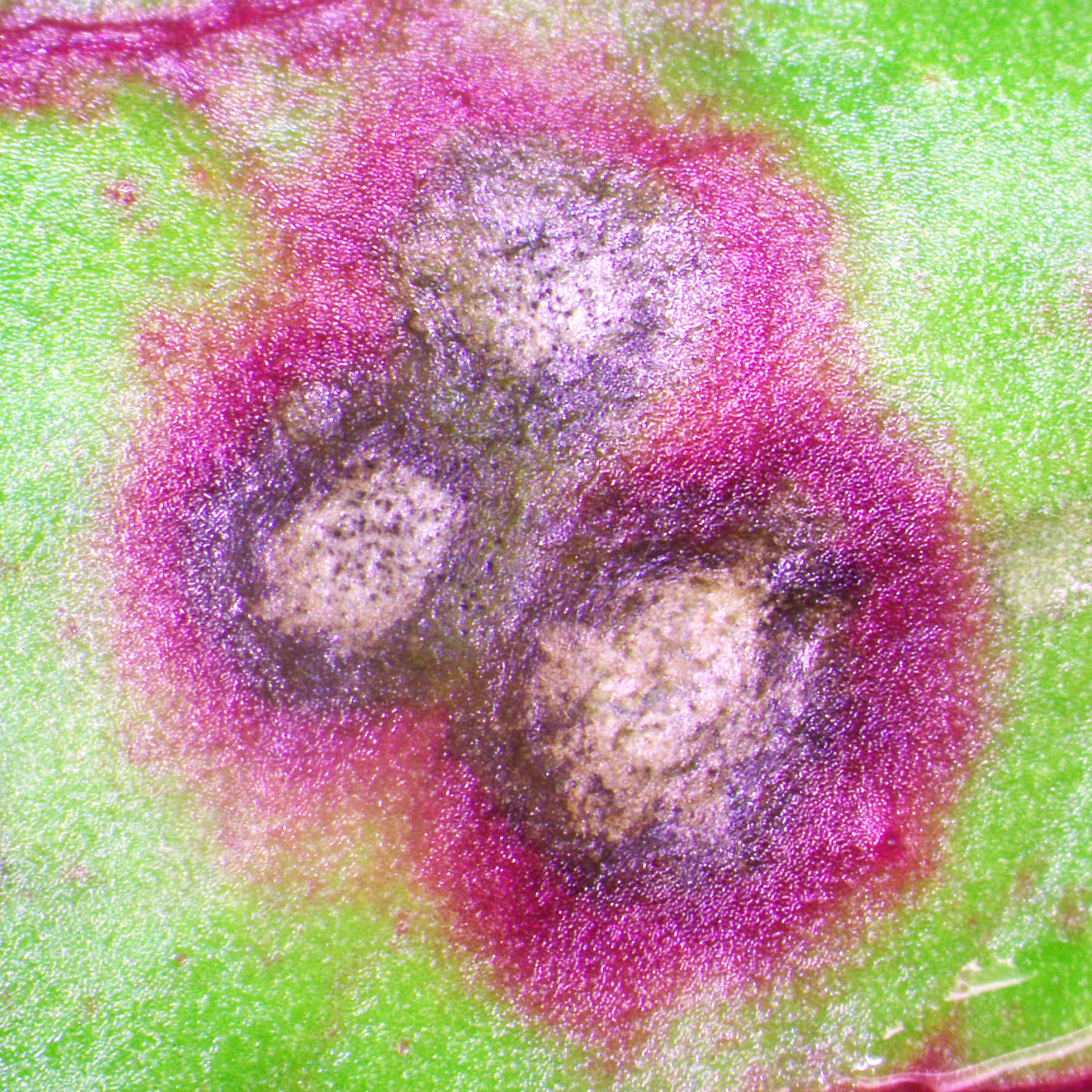
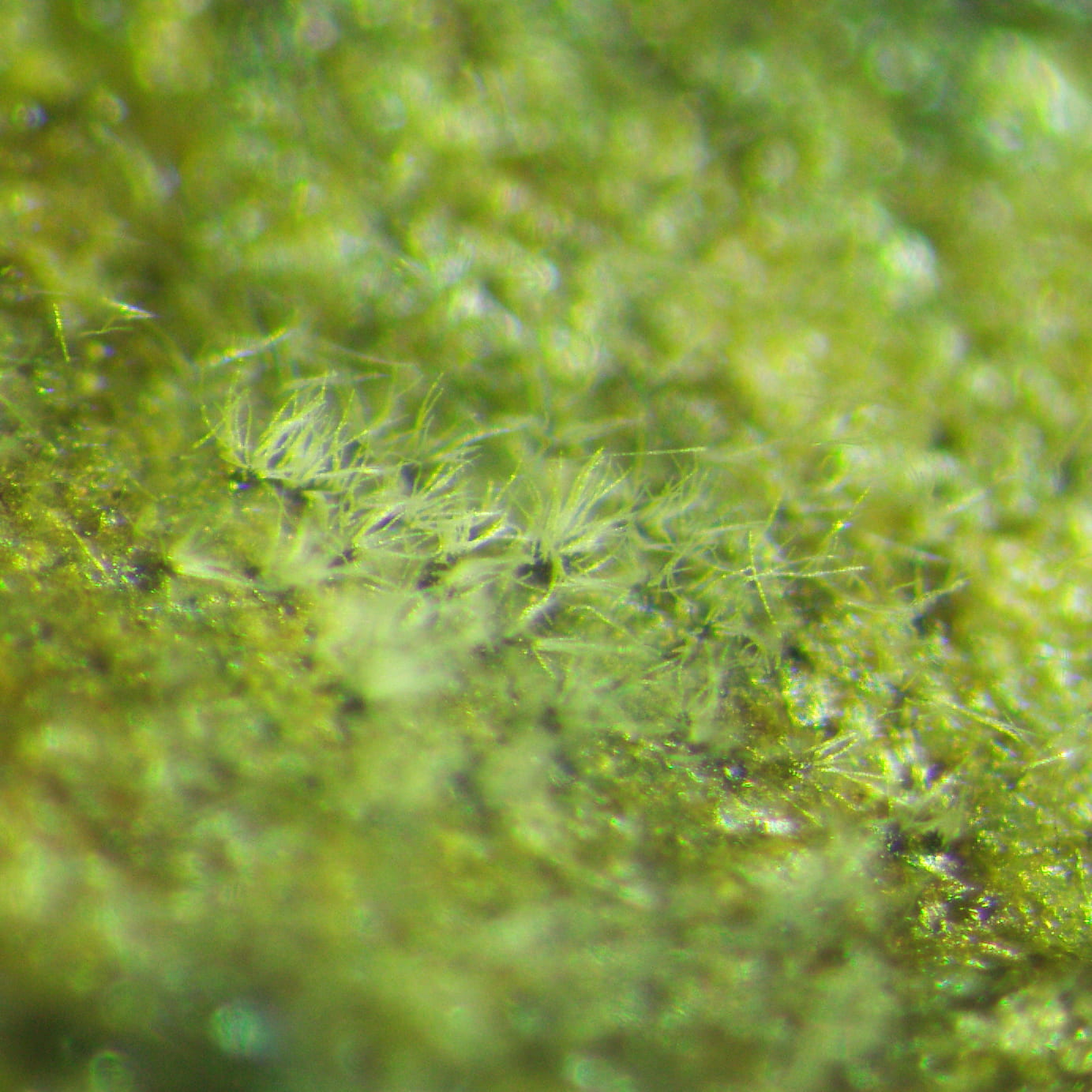
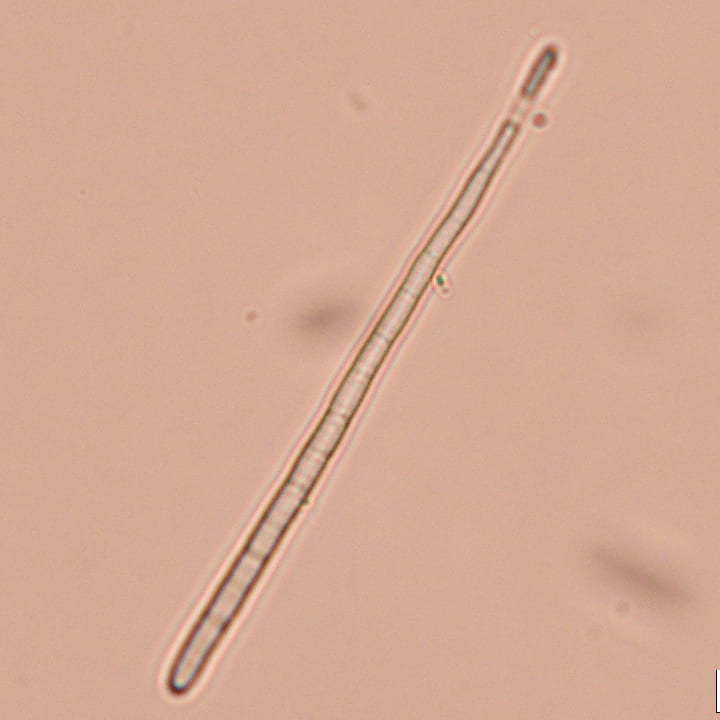
Disease Cycle
Cercospora beticola can overwinter in infested plant materials left from harvest (Fig. 3). C. beticola can also survive between growing seasons on alternative hosts (e.g., rotational crops, weeds) or seeds. Warm temperatures (75-80 ˚F) and prolonged periods of rain or high relative humidity, especially during the mid to late cropping season, are conducive for disease development. When the environment is favorable, C. beticola becomes active and can infect leaves forming distinct lesions. Lesions can quickly expand and coalesce to encompass the leaf. Each lesion contains hundreds of spores that may disperse by rain splash, wind, insects, workers, or equipment to cause several cycles of infections within a cropping season (Fig. 3). CLS may first appear as small diseased areas identified by the purpling of infected leaves that rapidly develop to necrotic lesions which further expand in size.
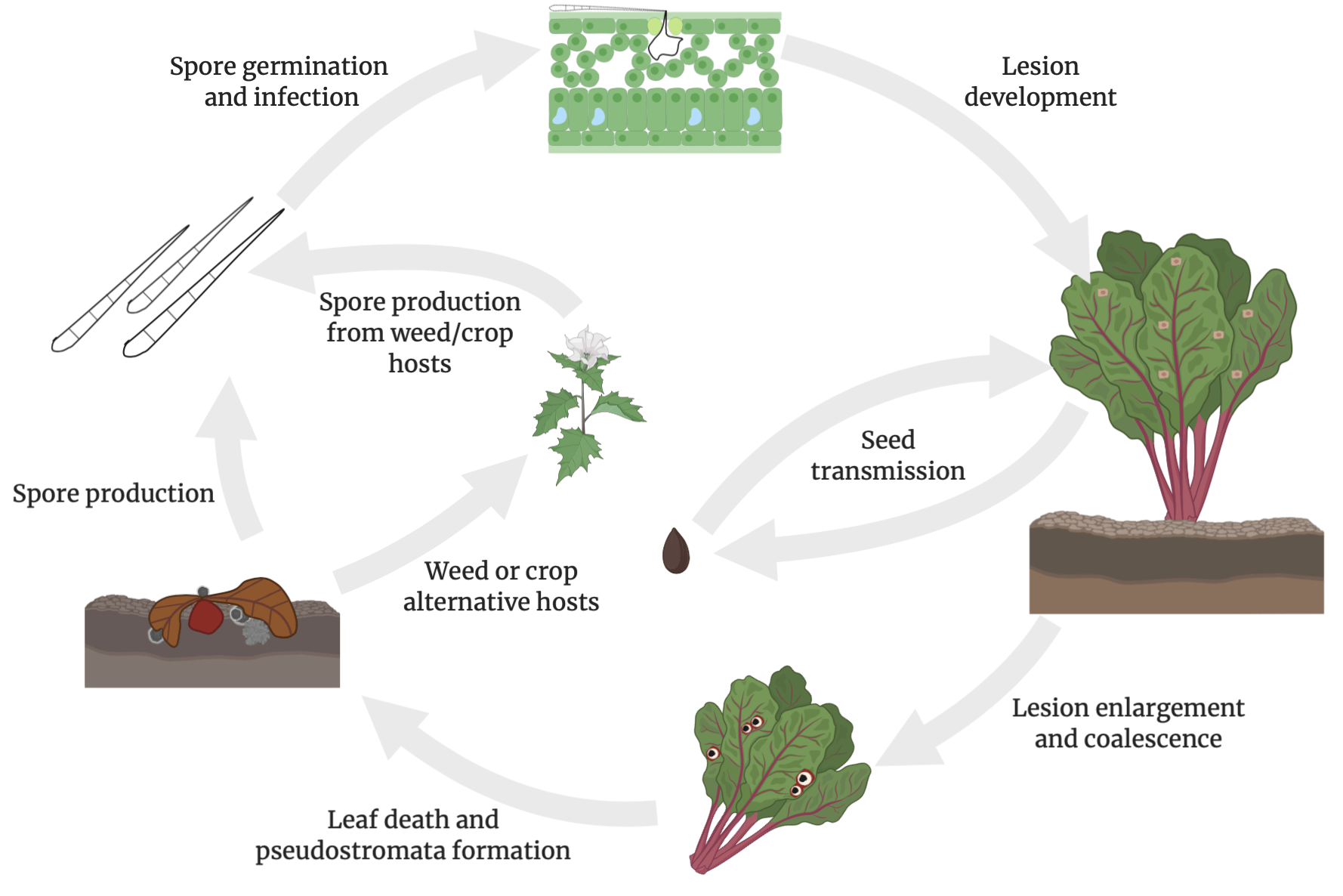
Managing Cercospora Leaf Spot
To design an effective management strategy for CLS in table beet we need to understand how the pathogen is introduced. Below are summaries of the key inoculum sources and management strategies for CLS.
Inoculum Sources:
Alternative Hosts
CLS can also occur on other crops belonging to Chenopodiaceae family such as Swiss chard (Fig. 4A), spinach, and sugar beet. Commonly encountered weeds also serve to perpetuate C. beticola inoculum including lambsquarters, and pigweed (Fig 4B).

Soil and Plant Residues
Cercospora beticola can survive in the soil on infested plant residues for up to 3 years.
Management Strategies:
Cultural practices
- Rotate with non-host crops for at least 3 years.
- Bury plant debris using deep tillage.
- Use of certified, fungicide-treated seeds.
- Optimize weed control (destroy weed hosts to remove green bridges for inoculum); and
- Minimize leaf wetness period by avoiding overhead irrigation. If irrigation is needed, applying overhead water at midday will minimize the time that leaves are wet and capable of being infected by the fungus. Consider drip irrigation where practical.
Plant Arrangement
Planting arrangements that decrease relative humidity and promote rapid leaf drying will reduce CLS spread but are also likely to increase root size. As broad-acre, processing production have a standard set of planting arrangements to adhere to the size requirements of specific markets, these practices are more applicable for fresh market production. Practices that support disease management include:
- Wide row spacing;
- Reducing plant populations within rows; and
- Orienting rows to encourage wind-flow.
Cultivar Selection
Table beet cultivars vary in their agronomic characteristics (e.g. root size, color, and shape) and susceptibility to CLS. In Cornell AgriTech research, table beet cultivars: Boldor, Detroit (Fig. 5A), Falcon, Merlin, Rhonda, and Touchstone Gold (Fig. 5B), were of similar susceptibility. Cultivar Ruby Queen was less susceptible to CLS than these cultivars.
Fungicides
Conventional Options: Conventional fungicides are available for the control of CLS on table beet. Fungicides significantly increase foliar health and extend leaf survival, but in most cases, do not significantly affect the dry weight of roots and root shoulder diameter. Preventative application of protectant fungicides prior to the infection and symptom development can give the best results. Resistance of C. beticola isolates has been reported to most fungicides with single-site mode of action. Most C. beticola populations in NY are resistant to strobilurin fungicides (FRAC 11) like Quadris (azoxystrobin). Even though strobilurins are preferred for Rhizoctonia root rot control, their use for management of CLS is discouraged. Moderate resistance to the demethylation inhibitor fungicide, Tilt (propiconazole (FRAC 3)) was observed in 30% of C. beticola isolates and high resistance in ~1% isolates, so DMI fungicides should be used with caution as to not put further, unnecessary pressure on the population. Miravis Prime (pydiflumetofen (FRAC 7) + fludioxonil (FRAC 12)), registered in 2020, was most effective fungicide for CLS control in our field experiments and may have a fit in high-risk zones. Alternating fungicides with different modes of action is important to preserve the efficacy of fungicides. Merivon (fluxapyroxad (FRAC 7) + pyraclostrobin (FRAC 11)), Luna Tranquility (fluopyram (FRAC 7) + pyrimethanil (FRAC 9)) or the microbial biopesticide, Double Nickel LC (Bacillus amyloliquefaciens strain D747; FRAC BM 02) also have some efficacy for CLS control and offer some rotational options with Tilt and Miravis Prime.
Organic Options: There are also a range of efficacious products registered for the control of CLS in organic table beet production. A tank mix of Cueva (copper octanoate; FRAC M 01) and Double Nickel LC resulted in significantly improved disease control in comparison to either product alone, and disease control was equivalent to conventional fungicides. LifeGard (Bacillus mycoides isolate J; FRAC P 06) has also provided similar CLS control to Cueva + Double Nickel.
More images:
- View LIHREC photo gallery: Cercospora leaf spot
More information:
Dr. Sarah J. Pethybridge (sjp277@cornell.edu)
Cornell AgriTech
211 Barton Laboratory
Geneva, New York
(315) 744-5359 (cell)
Dr. Julie R. Kikkert (jrk2@cornell.edu)
Cornell Cooperative Extension
Cornell Vegetable Program
Canandaigua, New York
(585) 394-3977 x 404 (office)
Prepared by Lori Koenick, Julie Kikkert and Sarah Pethybridge (July 2017). Revised by Pratibha Sharma (July 2021). Spanish translation by Natalia Pineros.


